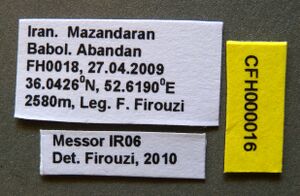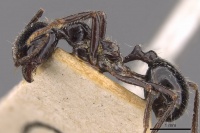Messor aralocaspius
| Messor aralocaspius | |
|---|---|

| |
| Scientific classification | |
| Kingdom: | Animalia |
| Phylum: | Arthropoda |
| Class: | Insecta |
| Order: | Hymenoptera |
| Family: | Formicidae |
| Subfamily: | Myrmicinae |
| Tribe: | Stenammini |
| Genus: | Messor |
| Species: | M. aralocaspius |
| Binomial name | |
| Messor aralocaspius (Ruzsky, 1902) | |
| Subspecies | |
| |
This is generally a highland species in Arabia and constructs relatively large crater nests (Collingwood and Agosti 1996).
Identification
Collingwood and Agosti (1996) - HW 1.9-2.4; EL/HW 0.19-0.23. The head is strongly striate and the whole of the alitrunk dorsum is transversely striate. All dorsal surfaces are covered with long pale hairs. The psammophore is moderately developed, never thick. The propodeum is angulate in profile but never dentate or spined.
Distribution
Occurrence in Macedonia and Montenegro is doubtful and these records are likely based on misidentifications (Borowiec, 2014).
Latitudinal Distribution Pattern
Latitudinal Range: 41.508577° to 13.6°.
| North Temperate |
North Subtropical |
Tropical | South Subtropical |
South Temperate |
- Source: AntMaps
Distribution based on Regional Taxon Lists
Afrotropical Region: Saudi Arabia.
Palaearctic Region: China, Iran, Iraq, Kuwait, Kyrgyzstan, Montenegro, North Macedonia, Russian Federation (type locality), Turkmenistan.
It is found in South East Europe, Saudi Arabia and Iraq (Abdul-Rassoul et al. 2013).
Distribution based on AntMaps
Distribution based on AntWeb specimens
Check data from AntWeb
Countries Occupied
| Number of countries occupied by this species based on AntWiki Regional Taxon Lists. In general, fewer countries occupied indicates a narrower range, while more countries indicates a more widespread species. |

|
Estimated Abundance
| Relative abundance based on number of AntMaps records per species (this species within the purple bar). Fewer records (to the left) indicates a less abundant/encountered species while more records (to the right) indicates more abundant/encountered species. |

|
Biology
Castes
Worker
   
| |
| . | |
Nomenclature
The following information is derived from Barry Bolton's Online Catalogue of the Ants of the World.
- aralocaspius. Aphaenogaster barbara var. aralocaspia Ruzsky, 1902c: 20 (w.) KAZAKHSTAN.
- Type-material: syntype workers.
- Type-locality: Kazakhstan: [journal not seen].
- Type-depository: ZMUM.
- Karavaiev, 1910b: 63 (q.m.); Stitz, 1930: 240 (q.).
- Combination in Aphaenogaster (Messor): Ruzsky, 1905b: 745;
- combination in Messor: Emery, 1908e: 449.
- As unavailable (infrasubspecific) name: Ruzsky, 1905b: 745; Emery, 1908e: 449; Karavaiev, 1910b: 62; Emery, 1921f: 71; Emery, 1922c: 94; Kuznetsov-Ugamsky, 1923: 257; Ruzsky, 1923: 4; Stitz, 1930: 240.
- Subspecies of barbarus: Kuznetsov-Ugamsky, 1927a: 90 (in key); Kuznetsov-Ugamsky, 1929d: 16.
- Subspecies of minor: Santschi, 1927c: 239; Santschi, 1927d: 247; Finzi, 1936: 159.
- Status as species: Pisarski, 1967: 384; Pisarski, 1969b: 306; Pisarski, 1970: 306; Tarbinsky, 1976: 65 (redescription); Arnol'di, 1977b: 1642 (in key); Dlussky, 1981a: 17; Collingwood, 1985: 248; Agosti & Collingwood, 1987a: 54; Agosti & Collingwood, 1987b: 270 (in key); Dlussky, Soyunov & Zabelin, 1990: 218; Bolton, 1995b: 252; Collingwood & Agosti, 1996: 315; Collingwood & Heatwole, 2000: 7; Petrov, 2006: 91 (in key); Schultz, R. et al. 2006: 206; He & Song, 2009: 722; Karaman, M.G. 2011b: 36; Guénard & Dunn, 2012: 45; Borowiec, L. 2014: 101 (see note in bibliography).
- Material of the unavailable name tamerlani referred here by Dlussky, Soyunov & Zabelin, 1990: 218.
- Distribution: Afghanistan, China, Iran, Kazakhstan, Kuwait, Kyrgyzstan, Mongolia, Saudi Arabia, Turkmenistan, Uzbekistan, Yemen.
- Current subspecies: nominal plus infumatus.
Description
References
- Abdul-Rassoul, M.S., Ali, H.B. & Augul, R.SH. 2013. New Records of Unidentified Ants worker (Hymenoptera: Formicidae: Myrmicinae) stored in Iraqi Natural History Museum with key to Species. Adv. Biores., Vol 4 (2): 27-33.
- Arnol'di, K. V. 1977b. Review of the harvester ants of the genus Messor (Hymenoptera, Formicidae) in the fauna of the USSR. Zool. Zh. 5 56: 1637-1648 (page 1642, Status as species)
- Borowiec, L. 2014. Catalogue of ants of Europe, the Mediterranean Basin and adjacent regions (Hymenoptera: Formicidae). Genus (Wroclaw) 25(1-2): 1-340.
- Bracko, G., Wagner, H.C., Schulz, A., Gioahin, E., Maticic, J., Trantnik, A. 2014. New investigation and a revised checklist of the ants (Hymenoptera: Formicidae) of the Republic of Macedonia. North-Western Journal of Zoology 10: 10-24.
- Collingwood, C. A. and D. Agosti. 1996. Formicidae (Insecta: Hymenoptera) of Saudi Arabia (part 2). Fauna Saudi Arabia. 15:300-385.
- Dlussky, G. M.; Soyunov, O. S.; Zabelin, S. I. 1990 [1989]. Ants of Turkmenistan. Ashkhabad: Ylym Press, 273 pp. (page 218, Material of the unavailable name tamerlani referred here.)
- Karavaiev, V. 1910. Nachtrag zu meinen "Ameisen aus Transcaspien und Turkestan". Rus. Entomol. Obozr. 9: 268-272 (page 63, queen, male described)
- Pisarski, B. 1967a. Fourmis (Hymenoptera: Formicidae) d'Afghanistan récoltées par M. Dr. K. Lindberg. Ann. Zool. (Warsaw) 24: 375-425 (page 384, Status as species)
- Pisarski, B. 1969b. 175. Myrmicidae und Formicidae. Ergebnisse der zoologischen Forschungen von Dr. Z. Kaszab in der Mongolei (Hymenoptera). Faun. Abh. (Dres.) 2(2 29: 295-316 (page 306, Status as species)
- Ruzsky, M. 1902c. The ants of the vicinity of the Aral Sea. Izv. Turkest. Otd. Imp. Rus. Geogr. Obshch. 3(1 1: 1-24 (page 20, worker described)
- Ruzsky, M. 1905b. The ants of Russia. (Formicariae Imperii Rossici). Systematics, geography and data on the biology of Russian ants. Part I. Tr. Obshch. Estestvoispyt. Imp. Kazan. Univ. 38(4-6 6: 1-800 (page 745, Combination in Messor)
- Salata, S., Demetriou, J., Georgiadis, C., Borowiec, L. 2023. The genus Messor Forel, 1890 (Hymenoptera: Formicidae) in Cyprus. Annales Zoologici 73(2): 215-234 (doi:10.3161/00034541anz2023.73.2.006).
- Salata, S., Lapeva-Gjonova, A., Georgiadis, C., Borowiec, L. 2023. Review of the Messor semirufus complex (Hymenoptera, Formicidae) in Greece. ZooKeys 1185, 105–142 (doi:10.3897/zookeys.1185.111484).
- Santschi, F. 1927d. Revision des Messor du groupe instabilis Sm. (Hymenopt.). Bol. R. Soc. Esp. Hist. Nat. 27: 225-250 (page 239, Stirps of minor)
- Stitz, H. 1930a. Entomologische Ergebnisse der Deutsch-Russischen Alai-Pamir Expedition 1928 (1). 5. Hymenoptera III. Formicidae. Mitt. Zool. Mus. Berl. 16: 238-240 (page 240, queen described)
- Tarbinsky, Y.S. 1976. The ants of Kirghizia. Frunze: Ilim, 217 pp. (page 65, Status as species)
- Zhu, W., Wu, L., Duan, L., Xu, S. 2022. A checklist of ants (Hymenoptera: Formicidae) in northern Shaanxi Province, China, with one new species of genus Proformica Ruzsky, 1902, Journal of Asia-Pacific Entomology 25, 101875 (doi:10.1016/j.aspen.2022.101875).
References based on Global Ant Biodiversity Informatics
- Borowiec L. 2014. Catalogue of ants of Europe, the Mediterranean Basin and adjacent regions (Hymenoptera: Formicidae). Genus (Wroclaw) 25(1-2): 1-340.
- Collingwood C. A. 1985. Hymenoptera: Fam. Formicidae of Saudi Arabia. Fauna of Saudi Arabia 7: 230-302.
- Collingwood C., and H. Heatwole. 2000. Ants from Northwestern China (Hymenoptera, Formicidae). Psyche 103 (1-2): 1-24.
- Collingwood, C. A.. "Hymenoptera: Fam. Formicidae of Saudi Arabia." Fauna of Saudi Arabia 7 (1985): 230-302.
- Dlussky G. M., O. S. Soyunov, and S. I. Zabelin. 1990. Ants of Turkmenistan. Ashkabad: Ylym Press, 273 pp.
- Firouzi F., S. P. Rad, S. H. Nezhad, and D. Agosti. 2011. Four new records of ants from Iran. Zoology in the Middle East 52: 7178.
- Guénard B., and R. R. Dunn. 2012. A checklist of the ants of China. Zootaxa 3558: 1-77.
- He D.-H., and L. Song. 2009. A taxon of the ant genus Messor Forel (Hymenoptera: Formicidae) from China, with description of two new species in desert region. Highlights of Sciencepaper Online 2: 720-725.
- Karaman M. G. 2011. A catalogue of the ants (Hymenoptera, Formicidae) of Montenegro. Podgorica: Catalogues 3, Volume 2, Montenegrin Academy of Sciences and Arts, 140 pp.
- Karavaiev V. 1911. Ameisen aus Transkaspien und Turkestan. Tr. Rus. Entomol. Obshch. 39: 1-72.
- Mokrousov M. V., and V.A. Zryanin. 2015. Materials on the early spring wasps and ants fauna of Uzbekistan (Hymenoptera: Vespomorpha: Chrysidoidea, Scolioidea, Pompiloidea, Vespoidea, Apoidea [Spheciformes], Formicoidea). Entomological research Russia and its neighboring regions 5: 36–48.
- Pekar, S. 2009. Capture Efficiency of an Ant-Eating Spider, Zodariellum asiaticum (Araneae: Zodariidae), from Kazakhstan. Journal of Arachnology 37(3):388-391
- Pisarski B. 1967. Fourmis (Hymenoptera: Formicidae) d'Afghanistan récoltées par M. Dr. K. Lindberg. Annales Zoologici (Warsaw) 24: 375-425.
- Ruzsky, M. 1923. Ants of Cheleken Island. Izv. Tomsk. Gos. Univ. 72(2nd p part: 1-6
- Schultz, R., A. G. Radchenko, and B. Seifert. "A critical checklist of the ants of Kyrgyzstan (Hymenoptera: Formicidae)." Myrmecologische Nachrichten 8 (2006): 201-207.

